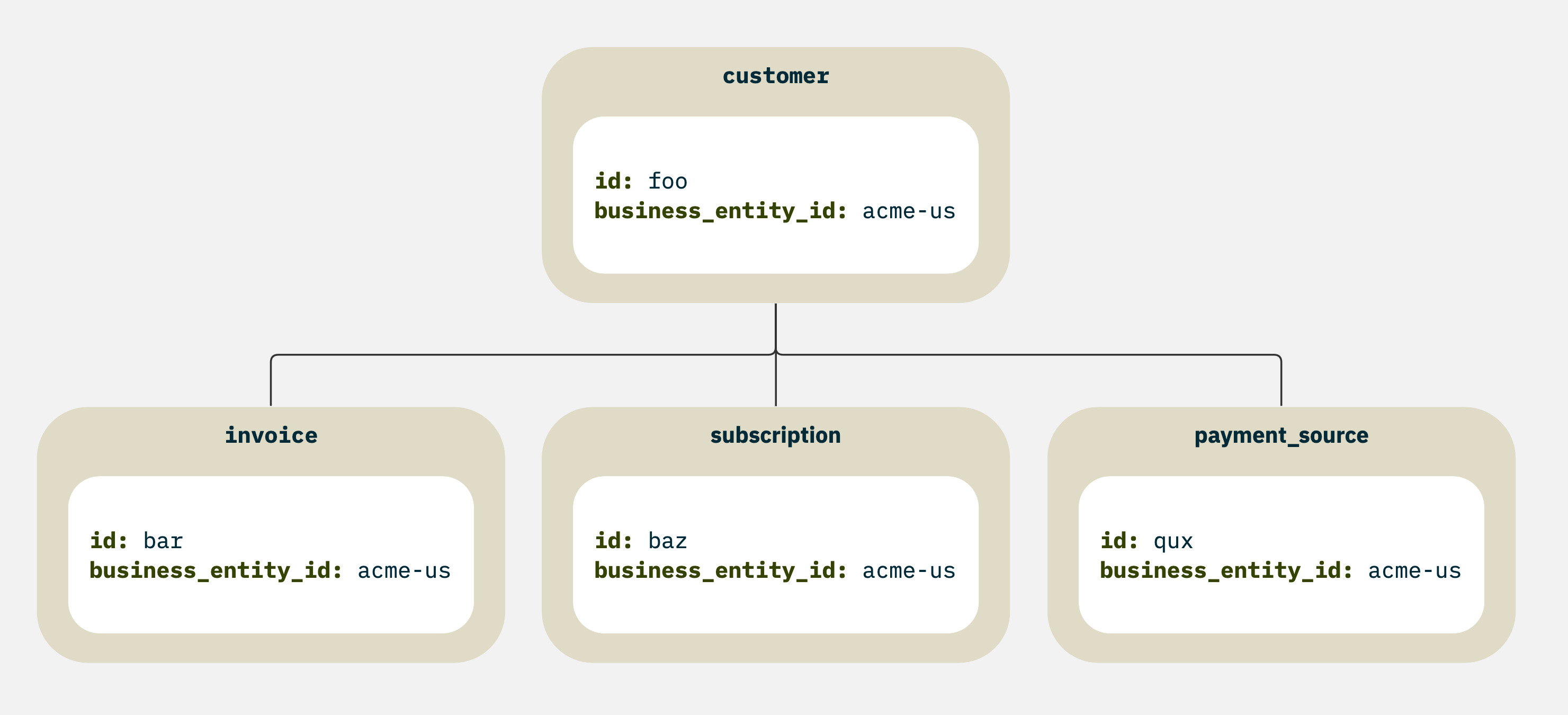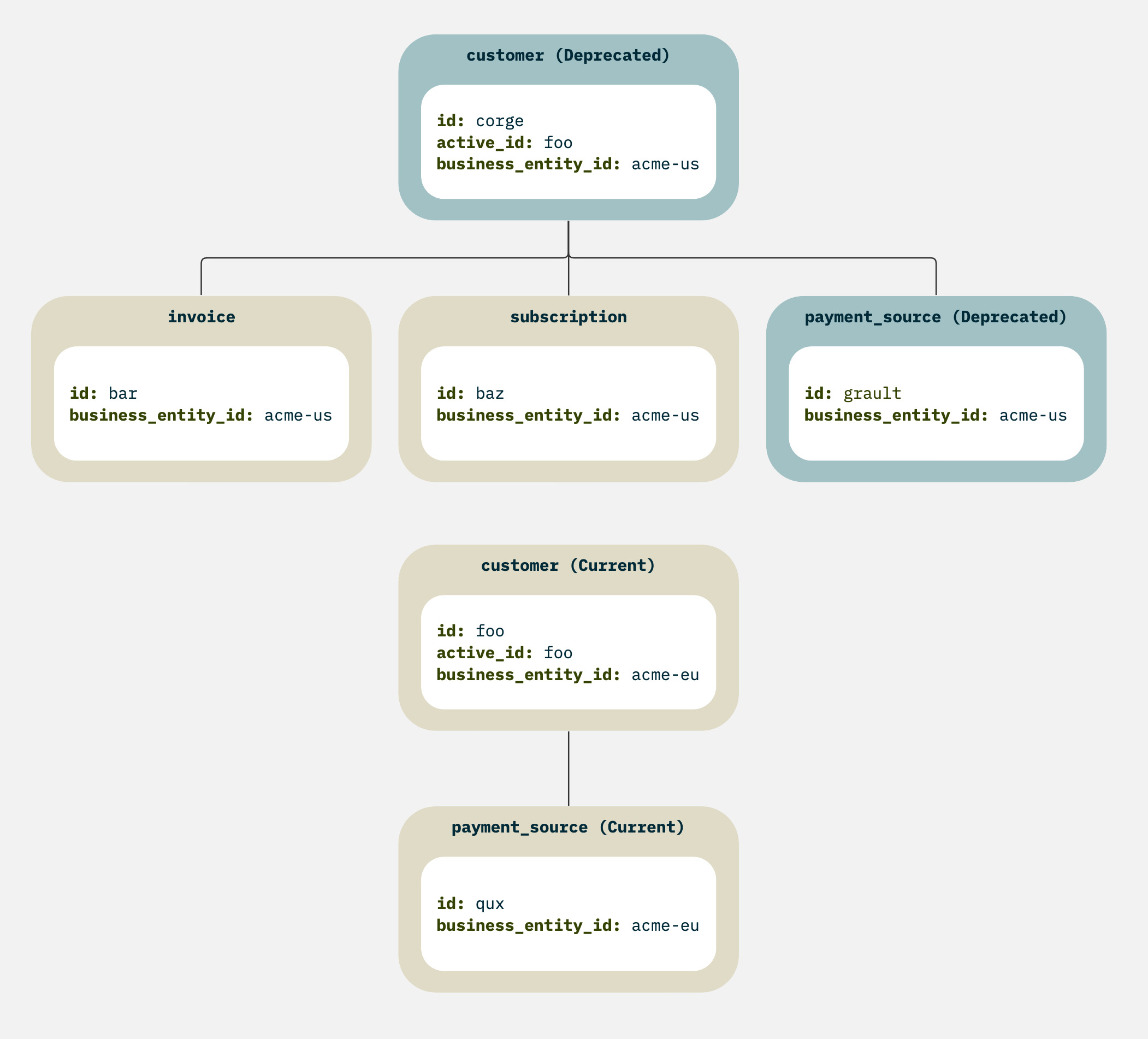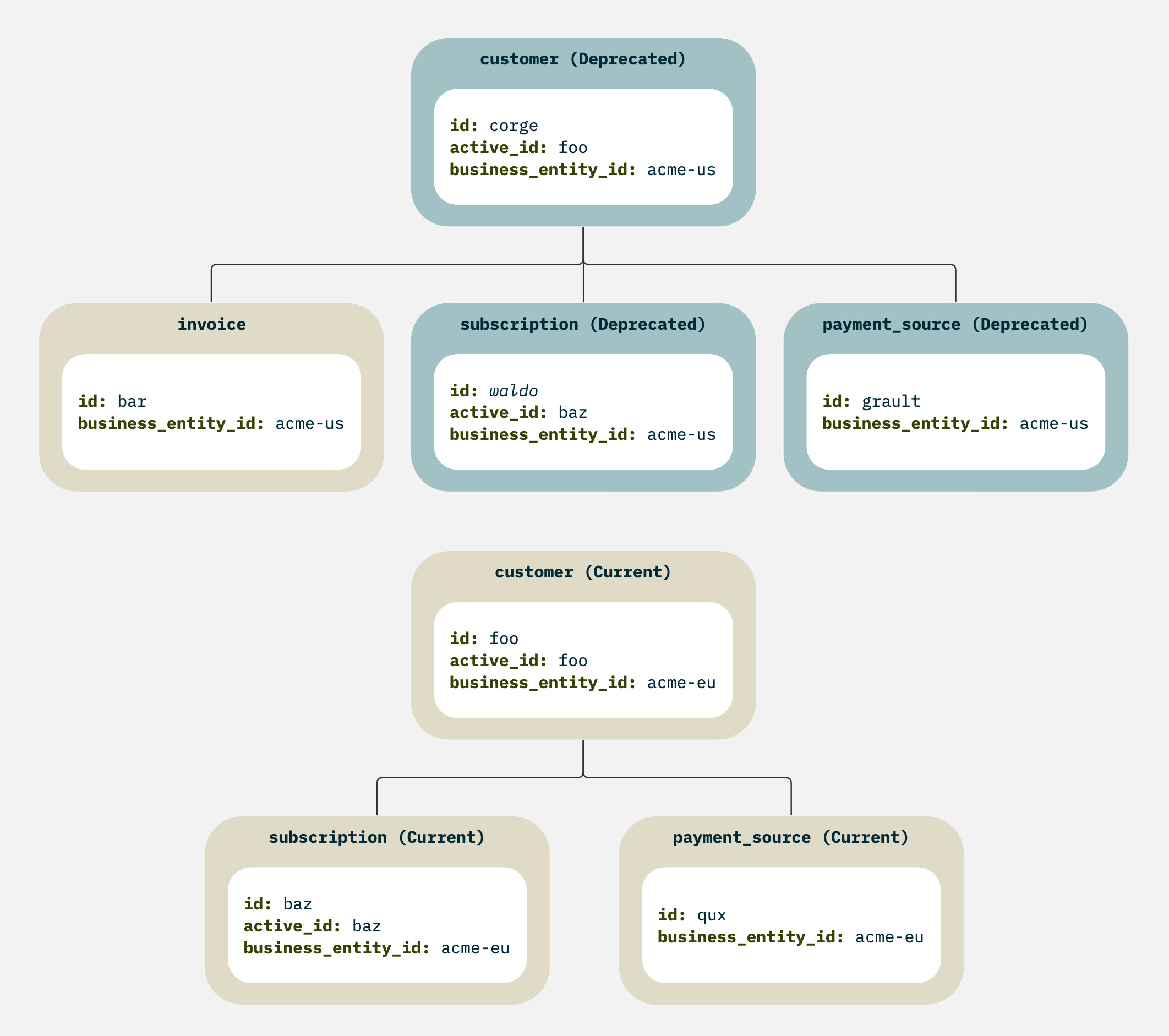Business entities
The business_entity resource represents a business unit or brand under your organization. Key resources in Chargebee Billing (such as customer, subscriptions, invoices, and transactions) along with the associated site configurations, fall under a business entity. Each Chargebee Billing site has one business entity by default. You may create multiple business entities in the following scenarios:
- Multiple Business Units: You may be running your business under different regional units with different "invoice-from" addresses. This is usually done to manage taxation and bookkeeping. In such a case, you may create a business entity for each business unit.
- Multiple Brands: You may have multiple brands within your business, such as those acquired via mergers and acquisitions. You may create a business entity for each brand.
Creating multiple business entities lets you separate configuration and data for your business units or brands so that you can manage their billing and revenue operations independently.
See also
More information on business entities and the configuration options available.
Specifying business entity in API operations
All API operations in Chargebee have site context. Context restrictions cannot be assigned to API keys. However, if your site has multiple business entities, you can specify the business entity context for an API call by passing a custom HTTP request header.
API behavior based on business entity specified
The table below explains how Chargebee responds to various API calls depending on whether the business entity ID is specified as part of the API call.
Note
Some of the words used here are defined in the Terminology section.
| Operation/Type of operation | Behavior | Examples |
|---|---|---|
Any operation that creates a customer resource |
|
|
Create a resource other than customer |
|
|
| Update/delete a resource |
| |
| List resources |
| |
| Retreive a resource |
|
Terminology
This section defines some useful terms for describing how business entities work.
Linked business entity
Any resource is always associated with precisely one and only one business entity. We call it the linked business entity of the resource, or simply, the business entity of the resource.
Default business entity
When customer resource is created and no business entity is specified, it is linked to the business entity designated as the default business entity of the site. A site always has a default business entity. Please choose the first business entity details carefully, as it can't be changed later, and this will be your default entity when no business entity is specified.
Context of an operation
Any site has data in it. This includes all the various resources such as customers, subscriptions, invoices, comments, and so on. The "context" of an API operation is the subset of site data it has access to. An API operation can only read or write data within its context. By default, an API operation has "site context", which means it has access to the entire site's data. However, when a business entity is specified in an API operation, it has "business entity context", which means that the operation only has access to the data linked to the business entity.
Example
Consider the List customers API. When you call the API without specifying a business entity, its context is that of the site and therefore returns customer resources for the entire site. However, when you specify a business entity, the context is only that of the business entity, and therefore the customer resources of only the selected business entity are returned.
Let's look at the Create checkout for a new subscription API. Say you're calling this API and providing the customer[id] parameter. When no business entity is specified, the operation has site context and therefore looks up the ID among all the customer resources in the site. However, when a business entity is provided, the operation has business entity context and looks up the ID only among the customers linked to that business entity.
Target resource
While creating an API resource other than a customer, you specify a target resource under which it should be created. For example:
- While creating an
invoiceresource for a one-time charge, you must specify either thecustomeror thesubscriptionresource to which it belongs. Thecustomerorsubscriptionresource, in this case, is the target resource of theinvoice. - While creating a
subscription, the target resource of asubscriptionresource is always acustomerresource. - While creating a
quoteresource oftypechange_subscription, the target resource is asubscriptionresource.
Sample business entity [ JSON ]
{
"id": "1",
"name": "1",
"status": "active",
"deleted": false,
"created_at": 1709892529,
"updated_at": 1709892626,
"resource_version": 1709892626000,
"object": "business_entity"
}API Index URL
Transfer a customer to another business entity ¶
Important This API will not work if you have specified a business entity in the custom HTTP header.
Transfers one or more customer resources from one business entity to another.
The transfer is executed by creating a copy of the customer resource. The original resource is deprecated, while the new copy becomes the active resource.
More details
Prerequisites
-
Transfers must always be initiated for an active
customerresources and never for a deprecated resources. -
A
customerresource cannot be transferred more than three times in a single calendar year. For example, if already moved thrice in the year 2023, acustomerresource can only be moved again in 2024. -
The
customerresource must not have any of the following:-
An account hierarchy
relationship. -
subscriptionresource withstatusin_trialor- advance invoice schedules. (
subscription.has_scheduled_advance_invoicesastrue.)
-
invoiceresource withstatusaspending. (Close pending invoices before invoking this API.) -
invoiceresources that are advance invoices. (invoice.has_advance_chargesastrue.) -
quoteresources withstatusasopenoraccepted. -
transactionresource with:statusasin_progressorstatusassuccess,typeasauthorization, and a non-zeroamount_capturable.
-
Non-zero
unbilled_charges. (Invoice unbilled charges before invoking this API.) -
Non-zero
refundable_credits. (Apply credits to unpaid invoices before invoking this API.)
-
-
The
customerresource must not be a gifter of a gift subscription withstatusscheduledorunclaimed.
Mechanics of business entity transfer
When calling this endpoint, the active and deprecated resources are processed as follows:
-
For the active resource:
idandactive_idare set to match the deprecated resource'sid.business_entity_idis set todestination_business_entity_idparameter.
-
For the deprecated resource:
- For
customerandsubscriptionresources, the value ofactive_idis set to match the resourceid. - The value of
idis changed to a new random value.
- For
Considerations for business entity transfer
-
When this API is endpoint is called, Chargebee blocks concurrent calls to incompatible
POSToperations. -
When a resource is transferred more than once, each transfer deprecates the previous active resource and creates a new active resource.
-
payment_sourceresources linked to thecustomerare immediately transferred to the destination business entity. -
subscriptionresources linked to thecustomerare transferred automatically to the destination business entity as follows:activesubscription resources are transferred on their next renewal.pausedsubscription resources are transferred when resumed.futuresubscription resources are transferred on theirstart_date.non_renewingandcancelledsubscription resources are not transferred and remain linked to the deprecated customer resource.
-
Other resources linked to the customer, such as
invoice,quote,credit_note, andtransaction, remain linked to the deprecated customer resource. -
Deprecated
customerandsubscriptionresources are not returned in list APIs such as List customers or List subscriptions.
See also
- Permitted operations on deprecated and active resources.
- Additional considerations for business entity transfer.
Example
The following example illustrates the transfer of a customer resource from a business entity (source) to another (destination). The example also shows how payment_source, subscription, and invoice resources attached to the customer resource are affected.
1. Initial state before the transfer
Imagine a customer
resource with the id
Ab6dRFt
belonging to the business entity acme-us
. This customer has a linked payment_source
, subscription
, and an invoice
.

2. Invoking the API endpoint
To transfer the customer resource to a new business entity acme-eu, you would call the endpoint as follows:
curl https://{site}.chargebee.com/api/v2/business_entities/transfers \
-u {api_key}:\
-d active_resource_ids[0]="Ab6dRFt" \
-d destination_business_entity_ids[0]="acme-us" \
-d reason_code[0]="correction"
The customer resource is deprecated in favor of a new active customer resource. Notice that the id of the deprecated customer resource is transferred to the new, active customer resource. Meanwhile, the deprecated resource is assigned a new random id.
The payment_source resource is also deprecated and a new active payment_source resource is created and linked to the new customer resource. Here too, the active resource adopts the id of the deprecated payment_source, which in turn is assigned a new random id.
The subscription and invoice resources remain linked to the deprecated customer resource.

3. Transfer of linked subscription resources
When the subscription renews, it automatically transfers to the business entity of the active customer resource. This process mirrors the transfer of the customer resource, resulting in a new active subscription resource linked to the active customer resource and the business entity acme-eu.

Sample Response [ JSON ]
URL Format POST
Input Parameters
The list of unique identifiers of the customer resources to be transferred. Each id must belong to an active customer resource.
Note
If a customer resource was deprecated because it was moved previously, you cannot move it again. Instead, move the active version of the resource. Do this by passing the active_id of the deprecated resource.
The list of reasons for changing the business entity of the corresponding
customer resources. Returns
Resource object representing business_entity_transfer
List business entity transfers ¶
Returns a list of business_entity_transfer resources meeting all the conditions specified in the filter parameters below. By default, this list is sorted by created_at in descending order (latest first).
Tip
To retrieve a history of all the business entity transfers for a resource, pass the filter parameters active_resource_id[is] and resource_type[].
Sample Response [ JSON ]
URL Format GET
Input Parameters
Filter Params
For operator usages, see the Pagination and Filtering section.
Filter business_entity_transfer resources based on resource_type.
Tip
Use this filter along with active_resource_id[is] to retrieve the history of all the business entity transfers for a resource.
Supported operators : is
Example → resource_type[is] = "customer"
Filter
business_entity_transfer resources based on resource_id. Supported operators : is
Example → resource_id[is] = "9bsvnHgsvmsI"
Filter business_entity_transfer resources based on active_resource_id.
Tip
Use this filter along with resource_type[ to retrieve the history of all the business entity transfers for a resource.
Supported operators : is
Example → active_resource_id[is] = "8gsnbYfsMLds"
Returns
Resource object representing business_entity_transfer
This attribute is returned only if more resources are present. To fetch the next set of resources use this value for the input parameter `offset`.







